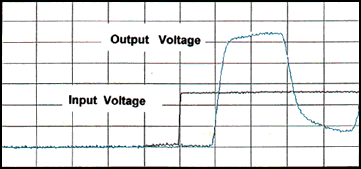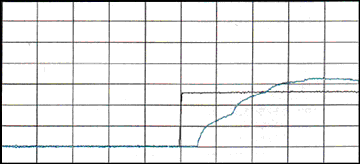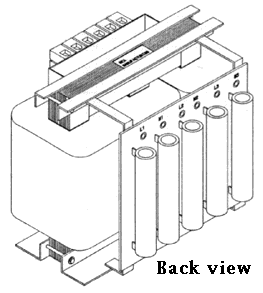| The Problem
The steep voltage wave fronts of the Pulse Width Modulated (PWM)
output of the Adjustable Frequency Drives (AFD) produce high frequency
effects which may damage the insulation of motors operated by the
equipment. The problems result from two distinct effects.
- High DV/DT Effects
The rapid rate of voltage rise (dv/dt) at the leading edges of each
output pulse of the PWM inverter, produces an uneven distribution of
voltage within the motor windings. The result is a concentration of
the voltage at the particular points of the winding causing abnormal
stress leading to breakdown of the insulation. This phenomena has
been described as "first coil breakdown" and is well
documented.
- Reflections in Long Lines & Cables
A long cable, in addition to resistance, has distributed inductance
and capacitance, producing effects similar to a transmission line as
shown below.

Delay Line Equivalent Circuit of Long Cable |
The high frequencies present in the output of PWM wave forms
cause reflections in long conductors connecting the motors to the
drives (see image below). Harmful effects with conductors as short
as 10 meters have been observed. However, the effects are most
severe with cables of lengths greater than 50 meters leading to the
doubling of the applied voltage. This translates to voltage peaks
approaching 1600 volts in 575 volt systems.

Cable Input & Output Voltage - Using No Filter
On the output of PWM inverters the voltage peak due to
reflections in long cable lines can be 200% (as shown in the image
above).
The combination of these two effects stresses the winding
insulation considerably beyond design limits and has been known to
shorten the insulation life and in some instances leads to early
catastrophic failure of motors.
The Solution
It has been demonstrated that these transient effects can be reduced
by using filters placed at the AFD's thereby allowing safe operation of
the motors and an expectation of full insulation life (see figure
below). After years of experience and research, a line
has been developed a comprehensive line of state of the art output filters
suitable for a wide range of prospective applications. The filters are
constructed using optimized combinations of inductors, capacitors and
resistors.

Cable Input & Output Voltage - Using Filter
By adding a motor guarding filter to the output of PWM
inverters the voltage peak is reduced to less than 125% appearing at the
motor as shown above.

Features of Rex AFD Output Filters
- The dv/dt is reduced to less than 200 volts per micro second
thereby insuring uniform voltage distribution along them the motor
winding.
- The prospective spike of 200% of applied voltage due to
reflections in long cables is reduced to less than 125% as shown
above. This and the combination of low dv/dt translates to safe
operation even at 575 volts input.
- Filter designs are suitable for a wide range of applications
including drive frequencies of 5 kilohertz and lines up to 200
meters in length.
- Filter designs are capable of suppressing reflection transients
even in the most severe cases involving cables with grounding metal
casings.
- The losses introduced in the use of these filters are small and
approach the losses experienced in using cables without filters. The
use of Output Filters generally introduce no additional
losses but merely transfer losses associated with charging and
discharging the line capacitance, from the cable to the filter. Thus
the use of filters practically has no effect on the
efficiency of the system.
- Components used in the filters are specified for specialized
qualities and are operated at a fraction of their design limitations
to reduce stress and provide reliability. These steps insure that
the filters will operate without overheating while exhibiting full
performance even at the limits of their specifications at the
extremes of the longest metal sheathed cables.
|


